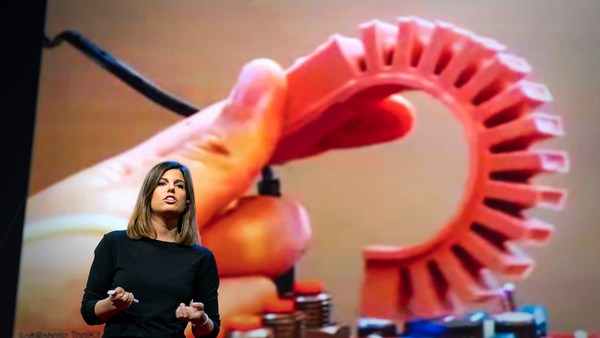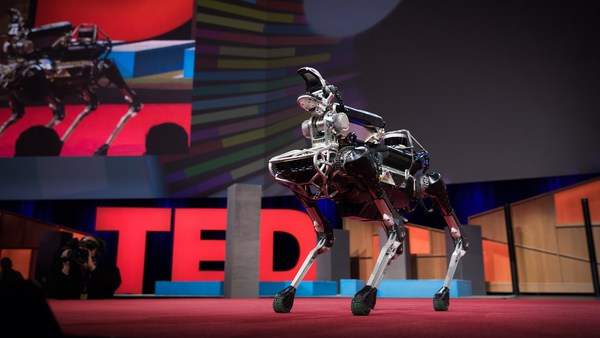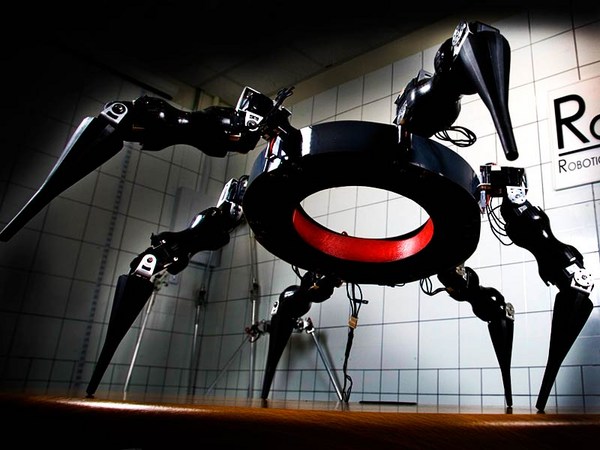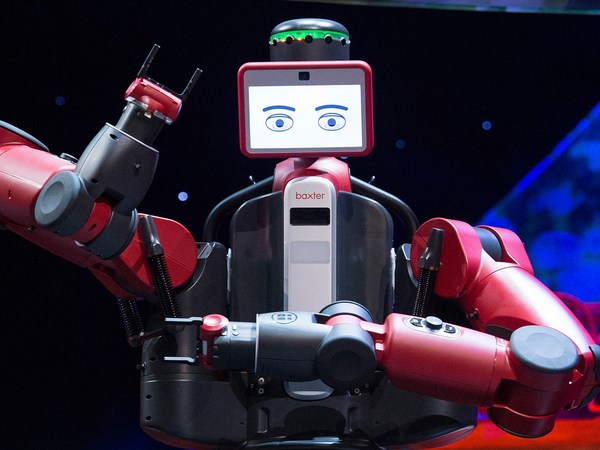As a roboticist, I get asked a lot of questions. "When we will they start serving me breakfast?" So I thought the future of robotics would be looking more like us. I thought they would look like me, so I built eyes that would simulate my eyes. I built fingers that are dextrous enough to serve me ... baseballs.
Classical robots like this are built and become functional based on the fixed number of joints and actuators. And this means their functionality and shape are already fixed at the moment of their conception. So even though this arm has a really nice throw -- it even hit the tripod at the end-- it's not meant for cooking you breakfast per se. It's not really suited for scrambled eggs.
So this was when I was hit by a new vision of future robotics: the transformers. They drive, they run, they fly, all depending on the ever-changing, new environment and task at hand. To make this a reality, you really have to rethink how robots are designed. So, imagine a robotic module in a polygon shape and using that simple polygon shape to reconstruct multiple different forms to create a new form of robot for different tasks. In CG, computer graphics, it's not any news -- it's been done for a while, and that's how most of the movies are made. But if you're trying to make a robot that's physically moving, it's a completely new story. It's a completely new paradigm.
But you've all done this. Who hasn't made a paper airplane, paper boat, paper crane? Origami is a versatile platform for designers. From a single sheet of paper, you can make multiple shapes, and if you don't like it, you unfold and fold back again. Any 3D form can be made from 2D surfaces by folding, and this is proven mathematically. And imagine if you were to have an intelligent sheet that can self-fold into any form it wants, anytime. And that's what I've been working on. I call this robotic origami, "robogami."
This is our first robogami transformation that was made by me about 10 years ago. From a flat-sheeted robot, it turns into a pyramid and back into a flat sheet and into a space shuttle. Quite cute.
Ten years later, with my group of ninja origami robotic researchers -- about 22 of them right now -- we have a new generation of robogamis, and they're a little more effective and they do more than that. So the new generation of robogamis actually serve a purpose. For example, this one actually navigates through different terrains autonomously. So when it's a dry and flat land, it crawls. And if it meets sudden rough terrain, it starts rolling. It does this -- it's the same robot -- but depending on which terrain it meets, it activates a different sequence of actuators that's on board. And once it meets an obstacle, it jumps over it. It does this by storing energy in each of its legs and releasing it and catapulting like a slingshot. And it even does gymnastics. Yay.
(Laughter)
So I just showed you what a single robogami can do. Imagine what they can do as a group. They can join forces to tackle more complex tasks. Each module, either active or passive, we can assemble them to create different shapes. Not only that, by controlling the folding joints, we're able to create and attack different tasks. The form is making new task space. And this time, what's most important is the assembly. They need to autonomously find each other in a different space, attach and detach, depending on the environment and task. And we can do this now.
So what's next? Our imagination.
This is a simulation of what you can achieve with this type of module. We decided that we were going to have a four-legged crawler turn into a little dog and make small gaits. With the same module, we can actually make it do something else: a manipulator, a typical, classical robotic task. So with a manipulator, it can pick up an object. Of course, you can add more modules to make the manipulator legs longer to attack or pick up objects that are bigger or smaller, or even have a third arm. For robogamis, there's no one fixed shape nor task. They can transform into anything, anywhere, anytime.
So how do you make them? The biggest technical challenge of robogami is keeping them super thin, flexible, but still remaining functional. They're composed of multiple layers of circuits, motors, microcontrollers and sensors, all in the single body, and when you control individual folding joints, you'll be able to achieve soft motions like that upon your command. Instead of being a single robot that is specifically made for a single task, robogamis are optimized to do multi-tasks. And this is quite important for the difficult and unique environments on the Earth as well as in space.
Space is a perfect environment for robogamis. You cannot afford to have one robot for one task. Who knows how many tasks you will encounter in space? What you want is a single robotic platform that can transform to do multi-tasks. What we want is a deck of thin robogami modules that can transform to do multiples of performing tasks. And don't take my word for it, because the European Space Agency and Swiss Space Center are sponsoring this exact concept.
So here you see a couple of images of reconfiguration of robogamis, exploring the foreign land aboveground, on the surface, as well as digging into the surface. It's not just exploration. For astronauts, they need additional help, because you cannot afford to bring interns up there, either.
(Laughter)
They have to do every tedious task. They may be simple, but super interactive. So you need robots to facilitate their experiments, assisting them with the communications and just docking onto surfaces to be their third arm holding different tools. But how will they be able to control robogamis, for example, outside the space station? In this case, I show a robogami that is holding space debris. You can work with your vision so that you can control them, but what would be better is having the sensation of touch directly transported onto the hands of the astronauts. And what you need is a haptic device, a haptic interface that recreates the sensation of touch. And using robogamis, we can do this.
This is the world's smallest haptic interface that can recreate a sensation of touch just underneath your fingertip. We do this by moving the robogami by microscopic and macroscopic movements at the stage. And by having this, not only will you be able to feel how big the object is, the roundness and the lines, but also the stiffness and the texture. Alex has this interface just underneath his thumb, and if he were to use this with VR goggles and hand controllers, now the virtual reality is no longer virtual. It becomes a tangible reality. The blue ball, red ball and black ball that he's looking at is no longer differentiated by colors. Now it is a rubber blue ball, sponge red ball and billiard black ball. This is now possible. Let me show you.
This is really the first time this is shown live in front of a public grand audience, so hopefully this works. So what you see here is an atlas of anatomy and the robogami haptic interface. So, like all the other reconfigurable robots, it multitasks. Not only is it going to serve as a mouse, but also a haptic interface.
So for example, we have a white background where there is no object. That means there is nothing to feel, so we can have a very, very flexible interface. Now, I use this as a mouse to approach skin, a muscular arm, so now let's feel his biceps, or shoulders. So now you see how much stiffer it becomes. Let's explore even more. Let's approach the ribcage. And as soon as I move on top of the ribcage and between the intercostal muscles, which is softer and harder, I can feel the difference of the stiffness. Take my word for it. So now you see, it's much stiffer in terms of the force it's giving back to my fingertip.
So I showed you the surfaces that aren't moving. How about if I were to approach something that moves, for example, like a beating heart? What would I feel?
(Applause)
This can be your beating heart. This can actually be inside your pocket while you're shopping online. Now you'll be able to feel the difference of the sweater that you're buying, how soft it is, if it's actually cashmere or not, or the bagel that you're trying to buy, how hard it is or how crispy it is. This is now possible.
The robotics technology is advancing to be more personalized and adaptive, to adapt to our everyday needs. This unique specie of reconfigurable robotics is actually the platform to provide this invisible, intuitive interface to meet our exact needs. These robots will no longer look like the characters from the movies. Instead, they will be whatever you want them to be.
Thank you.
(Applause)





